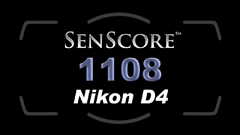|
Nikon D4
Specifications:
| Resolution: |
4928
x 3280 |
Pixel |
|
=
|
16.2 |
MP |
| Type: |
CMOS |
|
| Class: |
Full
Frame |
|
| Size: |
36.0
x 23.9 |
mm |
| Area: |
860.4 |
mm² |
| Photosite Size: |
7.3 |
μm |
| Bit Depth: |
14 |
bit |
| Manufacturer: |
Nikon |
|
| Launch: |
2012 |
|
Results:
| Noise: |
1148 |
σ
= 16.9 |
| Dynamic Range: |
1350 |
σ
= 6.6 |
| Color Range: |
1361 |
σ
= 6.7 |
| Tonal Range: |
1131 |
σ
= 6.7 |
| Resolving Power: |
551 |
σ
= 3.3 |
| SenScore™ |
1108 |
σ
= 3.7 |
Measured with: Nikon AF-S Nikkor 85mm f/1.4G
Number of bodies measured: 5
Comment:
The D4's sensor is unique in many ways. While not improving noise performance
significantly compared to its predecessor in the D3s, it raises the bar to new
heights in dynamic range, color range and tonal range. No other current sensor
comes even close in these categories. Combined with the still leading noise
performance, these extraordinary capabilities make the D4 the ideal camera for
low-light applications such as nighttime street photography, concert photography
and photojournalism. However, this unique sensor's exceptional performance comes
at a cost. It offers the lowest resolution of any full frame camera currently in
production while being one of the most expensive cameras available; certainly an
extraordinary situation. When looking at the results, one cannot help but come
to the conclusion that the designers of this sensor did not sacrifice resolving
power for noise performance - sensors with much smaller photosites such as the
one in the D800 are quite good when it comes to noise - they sacrificed resolution
for dynamic range, color range and to a lesser degree tonal range. Considering
this, it's hard not to worry about the performance of future super high
resolution sensors at anything but base ISO.
Badges:


|
|
|